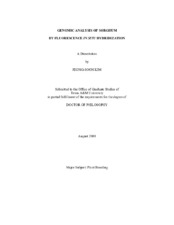| dc.description.abstract | The reliability of genome analysis and proficiency of genetic manipulation in vivo and in vitro are increased by assignment of linkage groups to specific chromosomes, placement of centromeres, orientation with respect to telomeres, and linear alignment with respect to chromosomal features and dimensions. I undertook five studies aimed at integrating sorghum genomics and cytogenetics at several levels. The results help establish an entirely new "cyto-genomics" resource, impacts of which are likely to be broad. In the first study, I developed a FISH-based karyotyping system for Sorghum bicolor Moench. I used integrated structural genomic resources, including linkage maps and large-insert clonal libraries of sorghum genomic DNA to develop a 17-locus probe cocktail for simultaneous fluorescent in situ hybridization (FISH). This probe enabled facile identification of all chromosome pairs in mitotic chromosome spreads. Perhaps just as important, I established time-efficient means to select sorghum BAC clones for multi-probe FISH. Thus, an integrated cyto-genomics system for sorghum can be constructed without need of chromosome flow sorting or microdissection, both of which are difficult and costly. In the second study, hybridization of DNA clones from 37 different genomic regions enabled the assignment of linkage groups and orientation of linkage maps to chromosomes. Comparisons between genetic and physical distances throughout the genome enabled a new nomenclature for linkage group designation in sorghum. The results provide an integrated nomenclature system of Sorghum bicolor chromosomes and linkage groups. In the third study, I created high-resolution maps by FISH to pachytene bivalents for two linkage groups (B and H), and defined relationships between pericentromeric heterochromatin, centromeres, mapped markers and recombination rates. These relationships will help guide the development and use of sorghum genomics. In the fifth study, I used FISH in two ongoing gene-targeted efforts. For the maturity gene ma5 and fertility restoration gene rfl, I estimated physical lengths between currently available flanking molecular markers. This enables estimation of recombination densities in these regions and assessment of the applicability of map-based and -assisted cloning. | en |


